 Next morning, you make it to the Galang jetty where a number of people are already waiting for the 9am boat. (Sometimes there's a second boat at 4:30pm, but no promise.) The speedboat passes Jembatan Lima, another minute and it's there.
The stop is short, but there are helping hands for the bicycle. The boat accelerates without delay. It travels at a speed above 50 km/h.
There are a few more stops until it heads across the sea to Tanjung Pinang on Pulau Bintan, which is 33km from Galang.
Next morning, you make it to the Galang jetty where a number of people are already waiting for the 9am boat. (Sometimes there's a second boat at 4:30pm, but no promise.) The speedboat passes Jembatan Lima, another minute and it's there.
The stop is short, but there are helping hands for the bicycle. The boat accelerates without delay. It travels at a speed above 50 km/h.
There are a few more stops until it heads across the sea to Tanjung Pinang on Pulau Bintan, which is 33km from Galang.
For Galang people, Tanjung Pinang has a very metropolitan feel. It's a city with lots of shops, markets, restaurants, hotels, industries and quite a few interesting things to see (refer to Lonely Planet). Internet can be accessed as well.
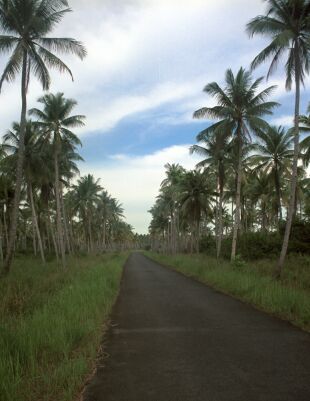 From here, the tour leads to the east coast, then up north, eventually west to Lagoi.
From here, the tour leads to the east coast, then up north, eventually west to Lagoi.
Asking for the airport, you get on the right track to the east coast. You find the spot where you have to turn left, asking the Ojek (motorcycle taxies) for the way to Gesik. At the Gesik Y-junction, turn right. Despite a few more motor vehicles, an enjoyable ride with a few opportunities to take a bath in streams.
Along the east coast are a number of tourist resorts (incomplete list):
- Bukit Berbunga Cottages Rp 50000, simple, relaxed
- Trikora Beach Resort - Sin$ 50/60 w/ aircon, luxurious
- Shady Shack - Rp 70000 for a wooden hut, nice beach location, newly renovated in 2003. Check out Mr Lobo's 2-storey huts, bedroom on the upper level, cool)
Right in the corner of Trigora IV Beach, just north of Bukit Teluk Dalam, this is not a resort but Maria's restaurant / shop / house. For some strange reason, tourists get stranded there and Maria welcomes them to spend the night in her home. The strangest thing that happened is that a Dutch lady who stayed at Maria's house got a baby. No English spoken.
Somehow you manage to find some sort of accommodation that night. While you sleep, some fishermen discuss how many gears your bike may have.
|

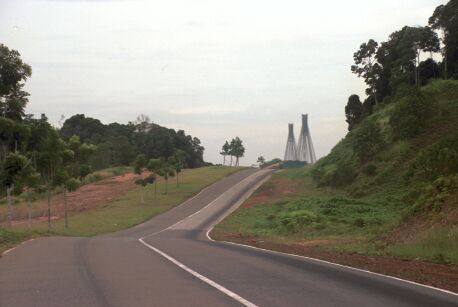 You head out in the direction of Muka Kuning Industrial Park, now and then asking for Simpang Jam. Once you reach the junction with the very minor clocktower, you ask for the way to Pulau Galang, the road with 6 bridges (jalan dengan enam jembatan).
You head out in the direction of Muka Kuning Industrial Park, now and then asking for Simpang Jam. Once you reach the junction with the very minor clocktower, you ask for the way to Pulau Galang, the road with 6 bridges (jalan dengan enam jembatan).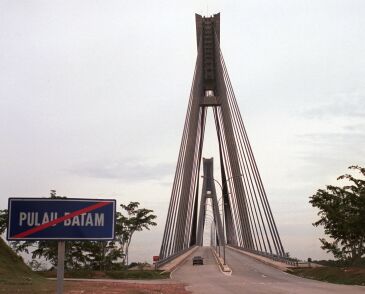 In the middle of the bridge you stop and sit down for a break (sometimes locals are selling snacks on the bridge), watch the boats, enjoy a fresh breeze.
In the middle of the bridge you stop and sit down for a break (sometimes locals are selling snacks on the bridge), watch the boats, enjoy a fresh breeze.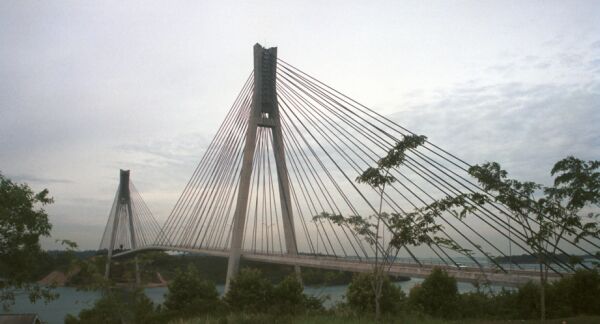
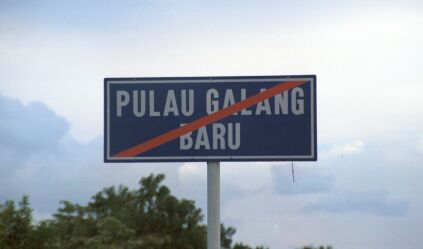 As you see this sign, you apply the breaks to avoid shooting over the edge of a cliff into the sea - there is no such thing as Jembatan Tujuh.
As you see this sign, you apply the breaks to avoid shooting over the edge of a cliff into the sea - there is no such thing as Jembatan Tujuh.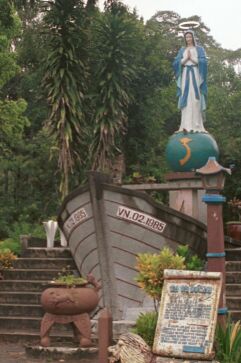 Next morning, you hit the road at 7am. You want to catch the 9am boat to Bintan, leaving from Galang, nearby Jembatan Lima.
Next morning, you hit the road at 7am. You want to catch the 9am boat to Bintan, leaving from Galang, nearby Jembatan Lima. You learn that there are two camps, Galang I and Galang II. These camps were once populated with refugees who sailed over from Vietnam. Today, the area is dotted with tempels, churches, and - mostly dilapidated - living quarters. A few people are around to do maintenance on the more interesting structures. On weekends, tourists visit the spot. Quite a few Vietnamese make it there, coming through Singapore.
That was interesting, but you missed the boat. You plan to kill the rest of the day on the beach.
You learn that there are two camps, Galang I and Galang II. These camps were once populated with refugees who sailed over from Vietnam. Today, the area is dotted with tempels, churches, and - mostly dilapidated - living quarters. A few people are around to do maintenance on the more interesting structures. On weekends, tourists visit the spot. Quite a few Vietnamese make it there, coming through Singapore.
That was interesting, but you missed the boat. You plan to kill the rest of the day on the beach.

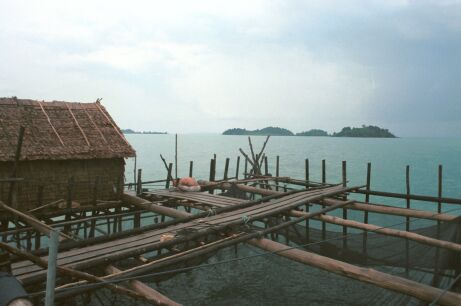 Let's say you're lucky and a local guy invites you to his private beach on the far northern end of the beach. You enjoy a clean swim and end up spending the night fishing on a kelong, an offshore platform from where a net is lowered into the sea and lights are set up to attract fish. After some hours, the net is pulled out. Spare time is spent sleeping and eating fish.
Let's say you're lucky and a local guy invites you to his private beach on the far northern end of the beach. You enjoy a clean swim and end up spending the night fishing on a kelong, an offshore platform from where a net is lowered into the sea and lights are set up to attract fish. After some hours, the net is pulled out. Spare time is spent sleeping and eating fish.

 Next morning, you make it to the Galang jetty where a number of people are already waiting for the 9am boat. (Sometimes there's a second boat at 4:30pm, but no promise.) The speedboat passes Jembatan Lima, another minute and it's there.
The stop is short, but there are helping hands for the bicycle. The boat accelerates without delay. It travels at a speed above 50 km/h.
There are a few more stops until it heads across the sea to Tanjung Pinang on Pulau Bintan, which is 33km from Galang.
Next morning, you make it to the Galang jetty where a number of people are already waiting for the 9am boat. (Sometimes there's a second boat at 4:30pm, but no promise.) The speedboat passes Jembatan Lima, another minute and it's there.
The stop is short, but there are helping hands for the bicycle. The boat accelerates without delay. It travels at a speed above 50 km/h.
There are a few more stops until it heads across the sea to Tanjung Pinang on Pulau Bintan, which is 33km from Galang. From here, the tour leads to the east coast, then up north, eventually west to Lagoi.
From here, the tour leads to the east coast, then up north, eventually west to Lagoi.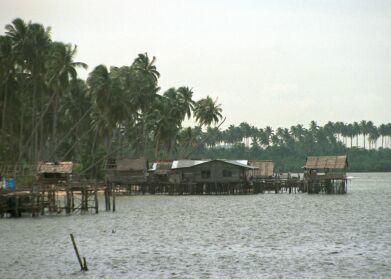 In the morning you head further north to Tanjung Berakit, the end of the road. There's a fishervillage and a beach, you relax for an hour, maybe have something to eat.
In the morning you head further north to Tanjung Berakit, the end of the road. There's a fishervillage and a beach, you relax for an hour, maybe have something to eat.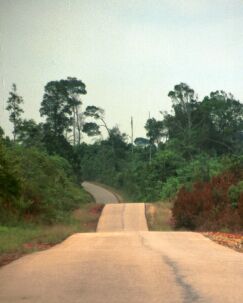 Now it's part of the way back, until you reach the Sialan junction, where you turn west. It's some km of hilly terrain, away from the sea. At major junctions you ask for the way to Lagoi. At one point you enter a nicely-done road, with a security checkpoint at the entrance. It looks like an airport-access-road. This one brings you to a junction where you follow the signs to the ferry terminal (all in English, now). Later there are signs that point you to the passenger terminal (Telok Sebung Ferry Terminal).
Now it's part of the way back, until you reach the Sialan junction, where you turn west. It's some km of hilly terrain, away from the sea. At major junctions you ask for the way to Lagoi. At one point you enter a nicely-done road, with a security checkpoint at the entrance. It looks like an airport-access-road. This one brings you to a junction where you follow the signs to the ferry terminal (all in English, now). Later there are signs that point you to the passenger terminal (Telok Sebung Ferry Terminal).
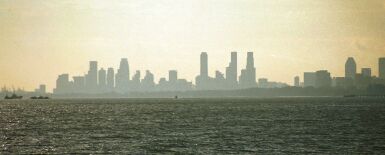 As you enter the terminal, you feel you're in a different world. Shops, little restaurants, nice and expensive, like an airport. You buy a ticket to Singapore, your ninth island. Bintan-Resort Ferries charge Sin$32 for a one-way ticket. The bike is an additional Sin$5.
As you enter the terminal, you feel you're in a different world. Shops, little restaurants, nice and expensive, like an airport. You buy a ticket to Singapore, your ninth island. Bintan-Resort Ferries charge Sin$32 for a one-way ticket. The bike is an additional Sin$5.